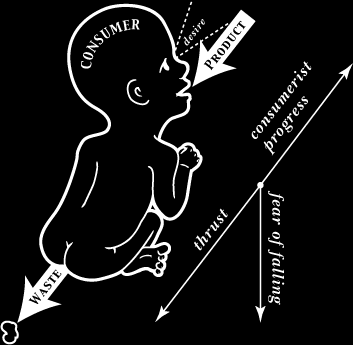In the geeky literature of engineering technocracy, Chicago is often glorified as the manifest destiny of its own self, an artifice of man built over the blank slate of the flat prairie, a literal incarnation of the city motto: "I Will". The rapid development of the city, its massive sprawl and world-record heights, how can this be explained? Could it exist anywhere else in time or space? Is it not a natural wonder of masculine bigness rising from swampy origins? A machine for living that soars in triumphant victory over the flatlands of mediocrity? Is its functioning the inevitable and unstoppable outcropping of natural economic forces? But the infrastructural accomplishments of this huge city are often ignored or unappreciated by even those who use them every day. Chicago is modest about its infrastructural achievements: these engineering wonders are not visually spectacular, indeed many of the marvels are not possible for the citizen to see at all. How many residents realize that right here in our city is the World's Largest Water Filtration Plant, the World's Largest Sewage Treatment Plant, vast networks of underground tunnels, hundreds of miles of alleys, even the World's Longest Street? But its not wise to get too caught up in these sorts of mechanical self-justifications. The technocratic world view of engineering, industry and modern capitalism would have us believe that progress is inevitable but also a never-ending march of hard-won competition and aggressive forward action. That those who do not progress are doomed to fall backwards or degenerate. A common metaphor is that of the shark which must keep moving constantly or die from lack of oxygen moving across its gills. As a corollary we offer this metaphorical diagram for the modern capitalist consumer:
In this economic model the only force that propels individual movement along the vector of consumerist progress is thrust generated by the consumption of product fuel and their destruction and expulsion as waste. To overcome the gravitational fear of falling (fear of bankruptcy, social ostracization, random disaster or general middle-class anxiety) an increasing amount of product must be destroyed and expelled in order to keep the consumer moving in a forward direction. As the speed of consumption and destruction increases, adequate digestion of product is not even possible, so that fully functional items are cast out behind simply because space is needed for newer purchases. Sales reports, housing starts, box office receipts and other measures of consumption are often used as measures of economic progress, but seen from a larger perspective it is the amount of waste produced by these processes which shows a true physical record of consumer activity. But the consumer is not encouraged to be conscious of this waste stream or pay attention to whether such destruction is necessary. We flush the waste away quickly or set it out in the alley where unseen hands whisk it away. To be overly concerned with waste, shit, or kaka as Freud might say, is seen as unhealthy, destructive and deviant. In this way the neglected infrastructural marvels of Chicago are unseen simply because we do not allow ourselves to look at them. To pay too much attention to the waste removal functions of the city's alimentary canal threatens progress, it is a dangerous reversal of direction that can only lead to self destruction, disease and corruption. For the scavenger, to accept these assumptions is to accept the degradation of the copraphagist, greedy to eat the feces of the next consumer ahead, attempting to exploit enough consumable fuel from this half-digested waste to keep himself or herself in an upward motion as well. The scavenger who seeks to profit from trash, to market societal sewage on ebay in order to get ahead, is in danger of contracting any number of communicable diseases from the filth they ingest. Those who view rejectamenta as an exploitable material, instead of as a gift, have not escaped the ruinous system pictured in the diagram above. Indeed they occupy the lowest rung of its mono-directional hierarchy. No, for the scavenger there must be another, more honorable, way of living. Recognizing the aforementioned shark metaphor as an anxiety-producing myth designed to increase consumption, with dangerous ecological implications for the world at large, the scavenger sees that the fear of falling is not the universal law of gravity it is made out to be. The scavenger is then freed to move about space in several dimensions, not simply the up-down axis of societal status. Viewing the infantile consumerist system from a larger perspective frees one from the artificial pull of its forces. By making use of resources at hand, whatever their source, the scavenger can live peacably with a minimum amount of waste, saving time and energy to devote to worthier pursuits than further unnecessary destruction and mindless consumption. In order to familiarize you with some of the hidden wonders of our great city, we offer a tour of some of the pathways of Chicago's alimentary canal: Arteries - the vast network of sub-streets and service entrances Domestic Deindustrialization - the reclamation of household appliances Plumbing - the Chicago River and the Water Reclamation District Solid Waste - the fluid stream of garbage leaving the city |
